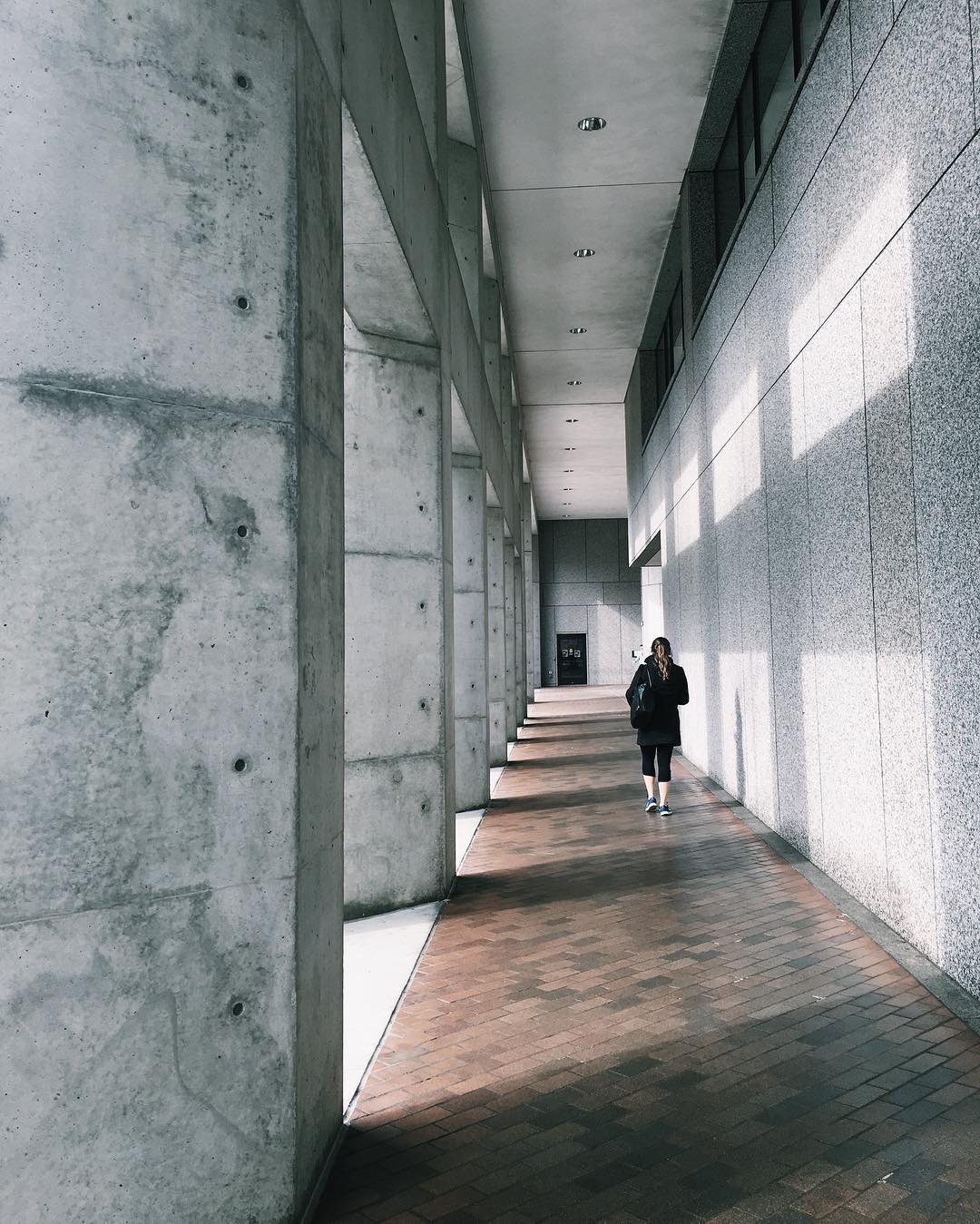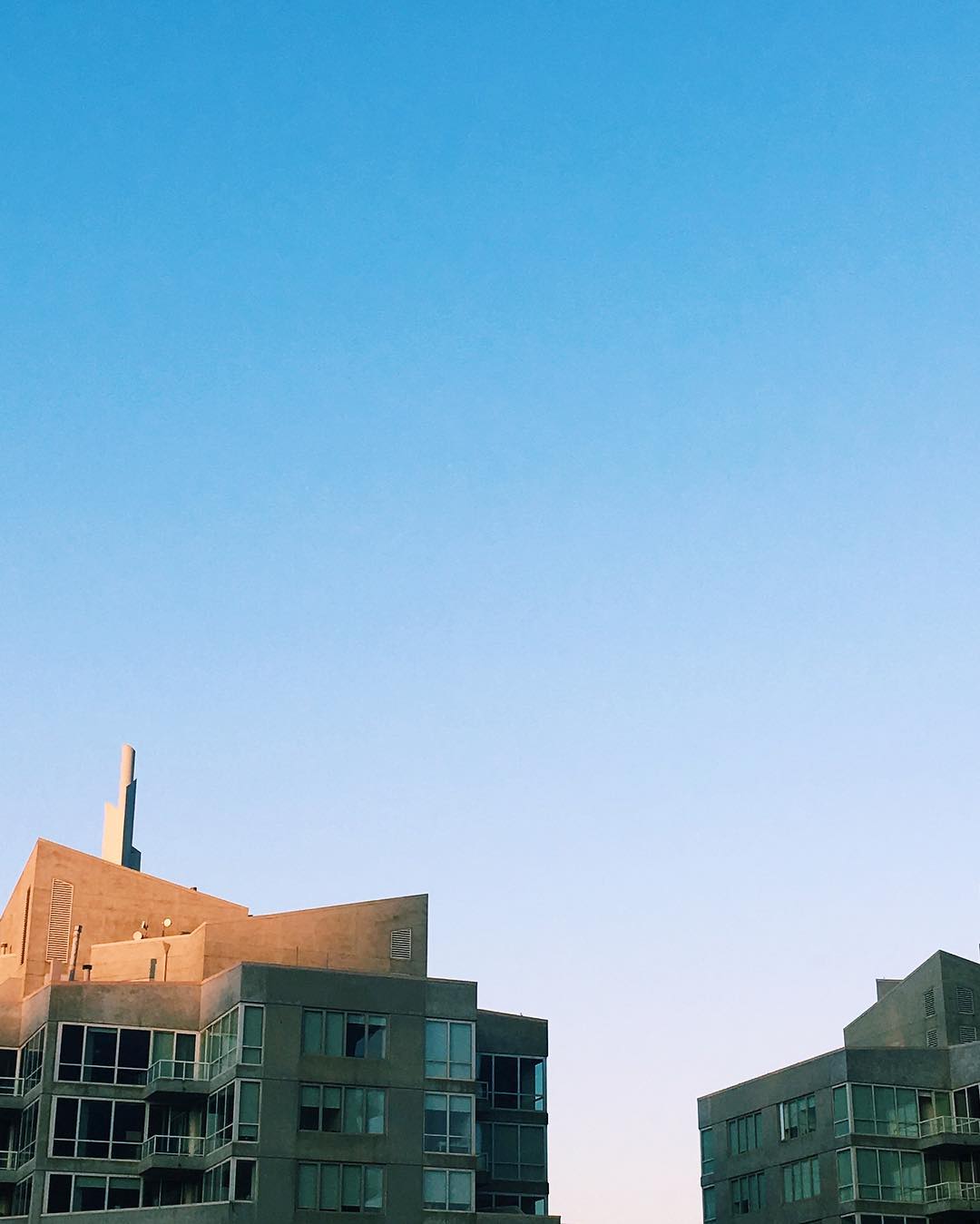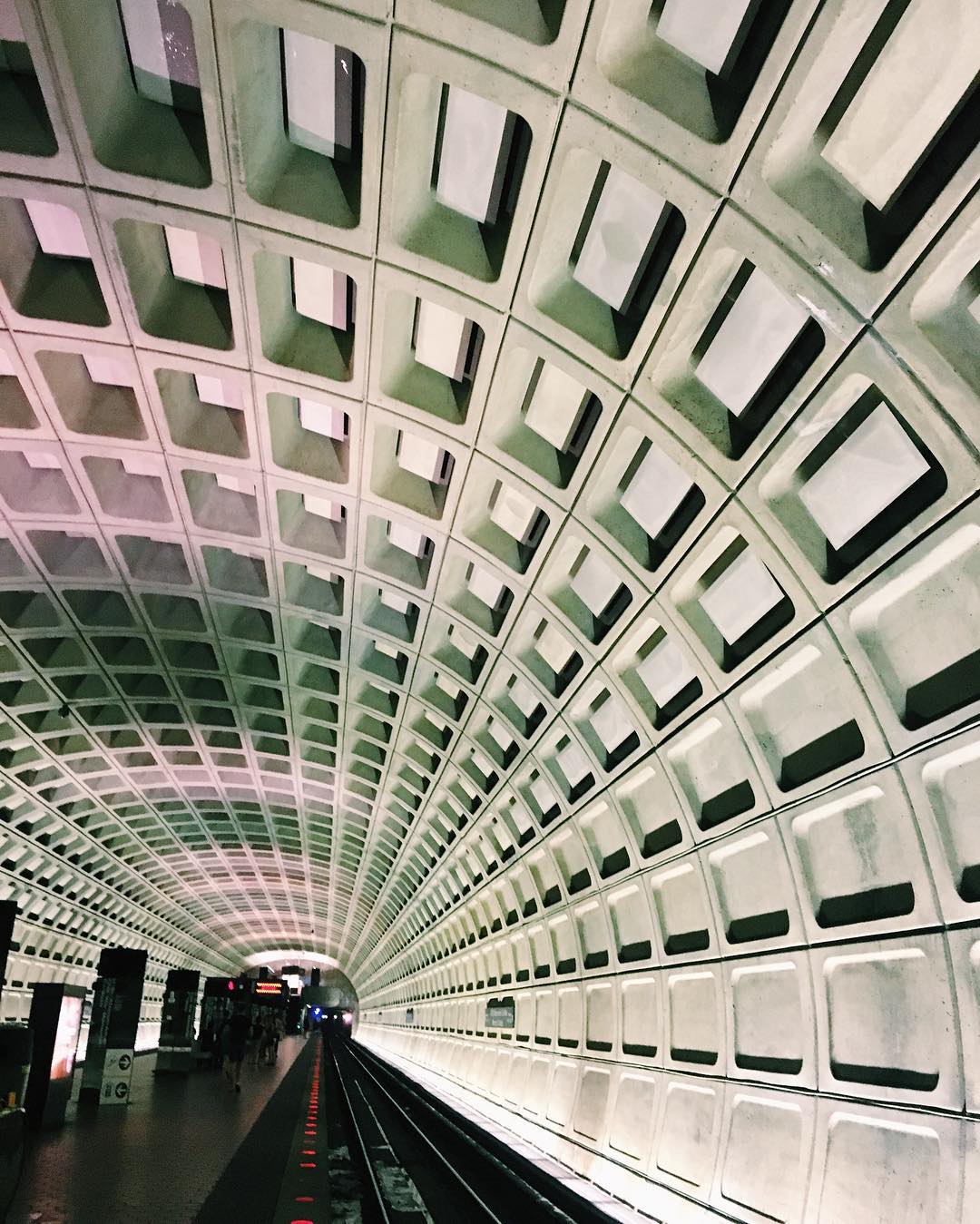Concrete Daydreams
Boston College has two main libraries. With spires that hit the New England sunset, the first library looks like the campus church. The second library is made of smooth concrete. Though the second library is used more often, it is loved so much less, with its monochromatic ugliness and solid lines. Still, work gets done between those worn gray walls.
One Wednesday during the spring of my senior year, I took a shortcut under the library’s heavy concrete ceiling. It was raining. The weak light filtering between the practical columns hit the gray with a small beauty. I took a picture. Later, uploading it to Instagram, I captioned it with the obvious phrase “brutalist Wednesday.”
 Boston College O’Neill Library taken by Carolyn Freeman
Boston College O’Neill Library taken by Carolyn Freeman
That semester, my life was both predictable and out of my own control, like a marble bouncing around inside a pinball machine. I didn’t know what track each day would take, but I was bounded within immovable margins, a proverbial marble with one way out—graduation—and an infinite number of ways to get there. I careened from breakfast to class to meetings. I applied to jobs I wanted and to jobs I knew I’d hate. I made spreadsheets.
Four weeks after that first picture, I noticed again how the line of the library looked against the clouds. I asked my friend to smile and I snapped another photo. Posting the weekly gray square on my feed gave me some semblance of control over the dizzying pinball machine, with its flashing lights and shallow fun.
Eventually, the person who runs the official Boston College Instagram account noticed the pictures and started reposting them. The phrase became a hashtag. Strangers followed me digitally. I was called out in the campus cafe for being the “brutalist Wednesday girl.”
But life goes on. The pinball machine shot me out. I graduated, armed with a Jesuit education, a job offer in sunny California, and a newfound love for clean lines and perpendicular architecture.
That summer, I spent two months in Washington, D.C. The graph paper ceiling of the Metro and sun-kissed concrete walls of America’s federal buildings dotted my feed. In August, I moved to San Francisco. The city is crowded with purple houses and palm trees, urban symbols with a hint of a tropical air. There aren’t any of the concrete buildings common to Boston and D.C., where the heavy lines of brutalist Wednesday run parallel to the harsh weather and straight-talking people. In California, the bright houses and short-sleeved runners create an unreal tableau.
Without the grounding grittiness of heavy-duty concrete buildings, San Francisco seems like fiction. It’s too pretty to be real, a perfect city in a snow globe where it never snows. Every weekend morning, joggers ran through the park across the street from my house. Golden retrievers looped to their waists yap happily alongside them. I could see the runners from my bed where I lay too late most mornings, waiting for the inevitable need for breakfast to overcome the suffocating desire to stay in bed. I could see the sunshine outside. I closed my curtains. In February, I accepted a job offer that would take me back to DC.
 The Embarcadero, San Francisco taken by Carolyn Freeman
The Embarcadero, San Francisco taken by Carolyn Freeman
During my six months in San Francisco, I cheated on brutalist Wednesday every other week. My first post in California was a picture of the DC Metro ceiling taken by a friend still in the city. Later, I posted pictures of shiny office windows, leaning apartment buildings, gray walls with light curving on them like a hyperbolic, washed-out rainbow, and once, on a day when I left work four hours early to lie in bed and try to breathe through my one unclogged nostril, I posted the sun through my curtains. I posted old pictures, or pictures of technically modernist buildings, though I doubted anyone noticed, and often, I didn’t post at all. Instead, I posted photos of light-touched purple houses and palm trees pricking the sunset. My feed morphed from Boston and DC’s washed out grays and blues to San Francisco’s painted skies. If I missed a concrete-doused Wednesday, old friends texted, asking if California had really changed me that much.
I brought suitcases of black skirts, shiny flats, and wrinkled blouses across the country. I packed black ballpoint pens and notebooks. I knew I would have time to write that I had never had in college and I thought it could be a reprieve from the professional world that would theoretically consume most of my time. But I got to work and everyone was in ripped jeans and white t-shirts and our CEO swore. And when I went home and tried to write, words furled out of me slowly and dumbly, like molasses spilling.
At work I had the mild kind of fun that happens when you sit next to ten other 22 year olds and at home I had the mild kind of stimulation that comes from reading top-ten recent fiction. I convinced myself that feeling flat, like a lake or a smooth pebble, was kind of a lovely thing. That the harshness of the ocean of my life out east wasn’t what made me happy, after all. Two months after I moved, I gave in and bought white canvas sneakers. The ocean washed them dirty.
When I went home for Christmas, I took the Metro to Union Station, where I took dozens of the same photo of the marbled ceiling and white washed columns. I stockpiled. I ate lunch with friends I’d known for a decade and a half. I went back to California.
Time passed for me in San Francisco like bricks laid by some mysterious carpenter. Eventually the building would be built, my internship would end, and I would go home buoyed, I thought, by an experience I held within me. In the meantime, each unit of time was solidly dense, impossible to make pass more quickly. I built a life hour by hour. It was nondescript. It was a wall of my own creation, unmarred by brothers or best friends. On the East Coast, those markers of a life stood stolidly.
It turns out that the elements that make up a life are comically shallow—the barista at the coffee shop around the corner making your order as soon as you walk in the door; roasting a whole chicken; exchanging playlists and realizing you both put “Don’t Think Twice, It’s All Right” on it; a library card. You can find these things anywhere.
Brutalism grew in America from the 1950s to the 1970s, when the backlash to the Modernist movement mandated simple buildings made from raw concrete. Brutalist buildings are made to exist, not to impress. It is a seemingly easy way to build a building. A child could build a brutalist building with a fistful of clay and a lack of imagination. Gray fades easily into both the sky and concrete sidewalks. In DC, all of the Metro stations were purposefully built from raw concrete to look cohesively brutalist. Trains rush past graph paper molded walls, leaving a whistle in their wake. Brutalist buildings are camouflaged in cities, where stone-faced people rush between office buildings and disappear into subway stations.
The national highway system was built from concrete. Cars across the country circle up into the sky on concrete paths. In San Francisco, the brightly colored houses and feathered trees give way to gray, elevated roads once the highway leaves the Outer Mission and hits Daly City. Brutalism circles the country. Its solidness was built to last. My cab ride to the airport took me under overpasses made from the same material as Boston College’s library.
In D.C., I moved to Petworth, where pastel rowhouses are pushed as closely together as baby teeth crowding a child’s mouth. My apartment in Haight-Ashbury, dusty blue and missing a living room, would fit in like an eyetooth. The irony isn’t lost on me.
I had a terrible cold for my last few days in San Francisco. From midweek until I flew out that Sunday, I could barely breathe from my nose and my left ear was completely clogged. I thought of the doomed character in Infinite Jest who suffocates with a bad cold after robbers tape over his mouth. I was not yet there, but when I woke up a 5 in the morning with a sense and a half robbed from me, I thought it might not be a terrible way to go out. On my last full day in the city, I went to an apothecary in the Mission and bought peppermint oil, which I imagined would clear my sinuses and my ear and—bonus!—allow me to maintain my irrational avoidance of drugstore cold remedies.
I left the apothecary, friend in tow, to meet someone at a shop a few blocks away. Inside the shop, I dabbed peppermint oil under my nostrils and inhaled deeply. I exhilarated in the burn, the sudden feeling of life that came with the intake of oxygen, the muscular way my lungs expanded. I put a drop of the oil on my friend’s finger. It spilled. A wave of peppermint rose up from the concrete floor to greet us, and we made a quick exit. Outside, he inhaled, and said he now knew what it felt like to live inside of a pack of gum. I reveled in my newly unblocked sinuses and lamented the fact that it hadn’t worked on my ear.
With only half of my hearing ability and none of my smelling ability, San Francisco International Airport was a softer experience. Once I checked my bags and was waiting at my gate, it was almost pleasant to effortlessly block out most of the chatter.
 Shaw, Washington, D.C. taken by Carolyn Freeman
Shaw, Washington, D.C. taken by Carolyn Freeman
I landed at Dulles International Airport at 1 in the morning. My dad picked me up and we circled the Washington Monument on our way home to the suburbs, skirting Virginia and DC proper. The monument glowed in the moonlight, its white brick reflecting the easy, smiling night. No one was around. American flags rustled in the wind. 100 pounds of suitcases sat behind us.
Dulles was one of the last pictures I posted for brutalist Wednesday before running off to the land of the pastel. With low, sloped, concrete ceilings, long windows, and light you have to squint into, it’s an obvious choice for Instagram. But Dulles wasn’t actually built in the brutalist style. It’s modernist, a similar architectural style, but one with more gentleness and fewer harsh angles. The truth is that I wasn’t, and still am not, devoted enough to the intricacies of brutalism to care about the exact classification of the buildings I post. In that way, I am a concrete opportunist. I am malleable.
I chose to come back east because the concreteness of brutalist architecture means I have fewer choices to make. I couldn’t predict the palm trees blowing in the breeze and the fog creeping over Golden Gate Park, or the ten degree difference in temperature between Haight-Ashbury and the Mission, where the sun actually shines. I choose familiarity. I choose a city of concrete, where the temperature is the same in every neighborhood, where I will never again be shocked by a ninety-degree hill on the way to get pizza. My last act of freedom, then, was feeling the bright intake of peppermint air, the recklessness of a ruined shop floor, and the knowledge that all cities are built on concrete.